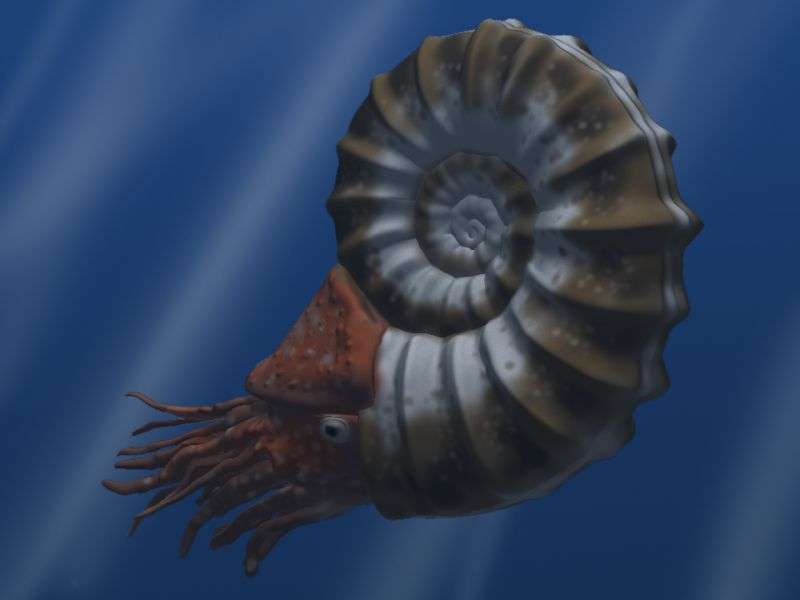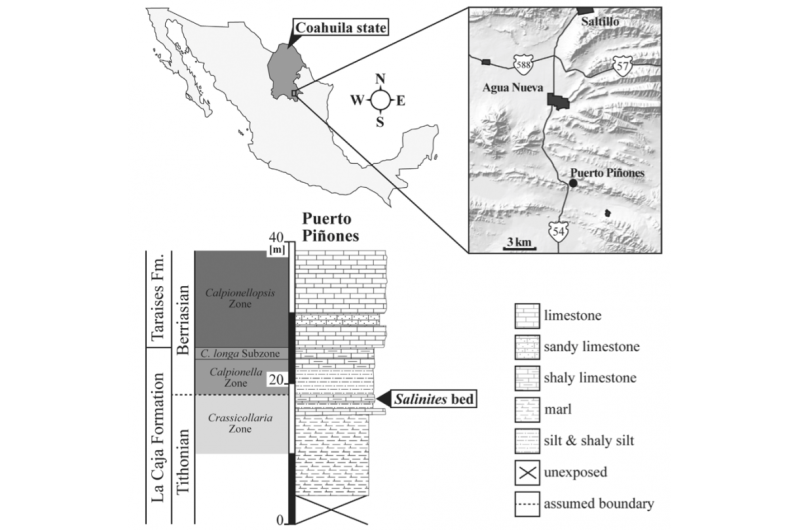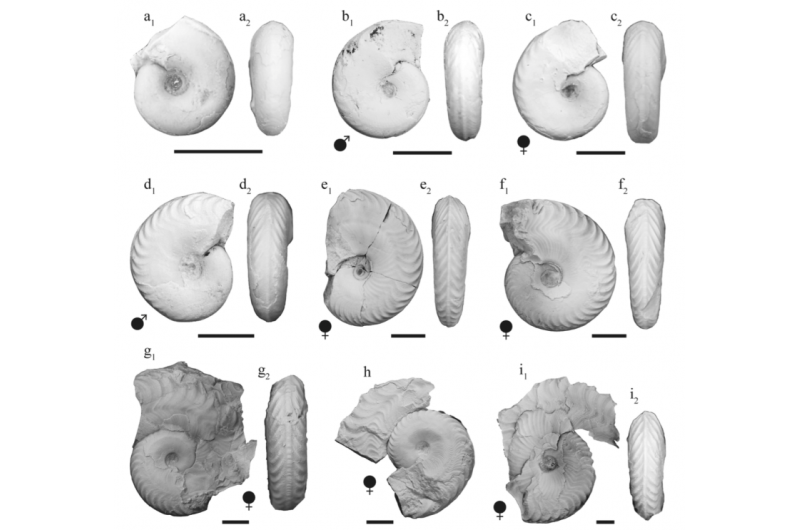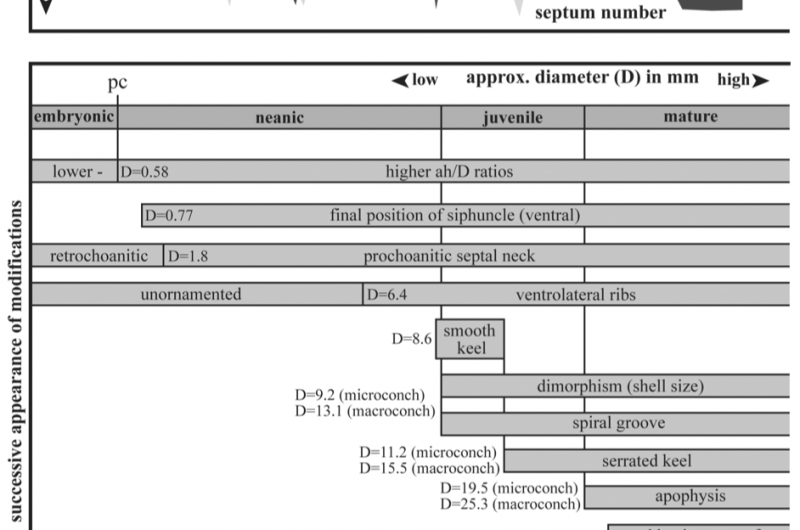A reconstruction of an ammonite Asteroceras. Credit: Nobu Tamura (spinops.blogspot.com)
Several years ago, back when I was working as the lab and collections manager for the St. George Dinosaur Discovery Site in St. George, Utah, we constructed a temporary exhibit with hundreds of ammonite shells from all over the world. One of our museum volunteers, an older French lady volunteering as a museum greeter and docent, refused to look at or go near the cabinet of ammonite shells. Confused, I asked her for her thoughts on the display. She shuddered, "Ack, they look like little snakes, coiled and ready to attack."
Aware of her ophidiophobia, I tried to explain to her that ammonites have absolutely nothing to do with snakes. But she wouldn't hear any of it. To me, the ammonites were beautiful fossils, exquisite and intricate, perfectly coiled, some with an iridescent patina increasing their aesthetic beauty. The variation was great from one shell to the next.
But I was (and arguably am still) poorly educated about ammonites, other than my basic knowledge that they were the shells of extinct cephalopods, with only their living relative Nautilus to remind us of what they may have looked like millions of years ago. Ammonites are fascinating, and like any other extinct organism, have a lot to tell us about the history of the planet we live on.
Paleontologists that study ammonites are like all paleontologists: they are working with a limited dataset based on what was preserved in the fossil record, and are restricted to interpreting what they have as best they can. But a new study published today in PLOS ONE provides a clearer picture of ammonites, particularly regarding their growth, their sexual behaviors, and their environment.
Map and stratigraphic column showing the locality for the Salinites beds. From Zell and Stinnesbeck (2016).
The new study, conducted by authors Patrick Zell and Wolfgang Stinnesbeck from Universität Heidelberg in Germany, examined a collection of 169 specimens of Salinites grossicostatum from the Tithonian La Caja Formation in Coahuila, Mexico, collected between 1986–1994 by Stinnesbeck. The specimens are three-dimensional and well-preserved, and yield a great deal of information on both external and internal characters, allowing Zell and Stinnesbeck to evaluate several morphological variables that can tell us about ontogeny, dimorphism, and even habitat preference for these ammonites.
The study found four distinct age stages (embryonic, neanic, juvenile, and mature). Embryonic stages have stronger variation in septal spacing, with a trend of crowding of septa as embryos, which the authors interpret to be related to hatching. As young ammonites transition to post-embryonic stages, Zell and Stinnesbeck observed a decrease in the distance between septa, and even note differential growth between males and females during the juvenile stage.
Sexual dimorphism in ammonites has lead to distinction in naming the smaller form the microconch and the larger form the macroconch, with many regarding the macroconchs as the female form to better accommodate egg production. This sexual variation has caused taxonomic confusion in the past, as previous studies had considered many dimorphic ammonites two distinct species; only more recently has it be recognized that they represented dimorphism, owing mainly to the fact that the two distinct forms were so often found together.
Representatives of Salinites at different ontogenetic stages. From Zell and Stinnesbeck (2016).
The presence of mature specimens of S. grossicostatum in the La Caja Formation is notably fewer in number than juveniles, but macroconchs and microconchs are found in approximately equal numbers, according to the authors of this study. The authors do note a geographic distribution pattern related to size, and infer that macroconchs (females), once having reached sexual maturity, may have migrated to shallow water environments after mating and fertilization in order to lay their eggs, where the microconchs (males) remained in what is interpreted as the outer shelf to uppermost slope environments. Some macroconchs after laying eggs, may have returned to the mating area for a possible second mating event. A similar distribution pattern is seen in other ammonites, as well as observed behavior in Nautilus, corroborating this potential behavior in the fossils.
Going back to the distance between septa seen in the shells of ammonites, there is an observed pattern of septal crowding that indicates the end of shell growth in mature ammonites, as once an ammonite reaches the end of growth it is producing less shell. This pattern is also observed by the authors regarding S. grossicostatum, with the last 12 septa in macroconchs being crowded together, and the last 4 septa in microconchs crowding together. Why the difference in the number of septa between macro- and microconchs? Well, Zell and Stinnesbeck interpret this disparity as a shorter life span for microconchs (sorry, dudes), whereas macroconchs have a prolonged lifespan to allow for migration and egg deposition.
Seasonal changes, such as temperature, oxygen availability, etc., and other life factors such as diseases, stress from predation, etc., can produce spikes in the variability of septal distances in ammonite shells. This study published in PLOS ONE proposes that some of the variability seen in S. grossicostatum can be due to environmental factors, and correlates known climatic changes seen in the geologic record to variation in septal distances seen in S. grossicostatum. Specifically, an oceanic upwelling in the La Caja Ocean could have provided nutrient-rich conditions for S. grossicostatum for much of the year, but during monsoonal seasons may have limited upwelling, and thus, food sources. An abundance of juvenile Salinites grossicostatum may be related to these upwelling episodes, as well as noted variation in septal distances in juvenile and mature specimens.
This new study by Zell and Stinnesbeck, out today in PLOS ONE, is a clear and comprehensive snapshot of ammonite morphology, growth, and behavior, and shows that fossils contain a trove of information, not just about the organism itself, but the habitat it lived in as well.
Ontogenetic reconstruction of Salinites grossicostatum based on external and internal characteristics. From Zell and Stinnesbeck (2016)
More information: Patrick Zell et al. Paleobiology of the Latest Tithonian (Late Jurassic) Ammonite Salinites grossicostatum Inferred from Internal and External Shell Parameters, PLOS ONE (2016). DOI: 10.1371/journal.pone.0145865
Journal information: PLoS ONE
Provided by Public Library of Science
This story is republished courtesy of PLOS Blogs: blogs.plos.org.



























